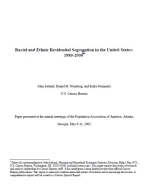
An official website of the United States government
Here’s how you know
Official websites use .gov
A .gov website belongs to an official government organization in the United States.
Secure .gov websites use HTTPS
A lock (
) or https:// means you’ve safely connected to the .gov website. Share sensitive information only on official, secure websites.
-
//
- Census.gov /
- Library /
- Census Working Papers /
- Racial and Ethnic Residential Segregation in the U.S.: 1980-2000
Racial and Ethnic Residential Segregation in the United States: 1980-2000
Racial and Ethnic Residential Segregation in the United States: 1980-2000
We examine trends in five dimensions of segregation for African Americans, Hispanics, Asians and Pacific Islanders, and American Indians and Alaska Natives: evenness, exposure, concentration, centralization, and clustering. The trend for African Americans is clearest— declines in segregation over the 1980 to 2000 period, regardless of the dimension considered. Nevertheless, segregation is still higher for African Americans than for the other groups across all measures. Latinos are generally the next most highly segregated group, followed by Asians and Pacific Islanders and then American Indians and Alaska Natives. Asians and Pacific Islanders and Hispanics both tended to experience increases in segregation over the period, though not across all dimensions. Increases were generally larger for Asians and Pacific Islanders than for Hispanics. The story of American Indian and Alaska Native residential segregation is mixed, with declines across some dimensions of segregation and increases in others.
Share
Related Information
Some content on this site is available in several different electronic formats. Some of the files may require a plug-in or additional software to view.
 Yes
Yes
 No
NoComments or suggestions?


Top

